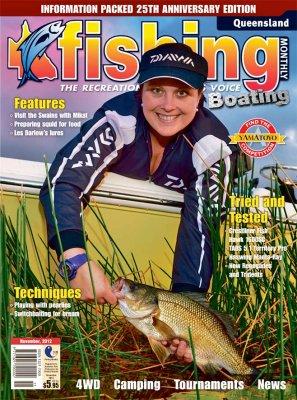Pearl perch by Kim Bain

Once upon a time, before bag limits and upper size restrictions for snapper came into being, we would fish for snapper in winter and we'd fish for pearl perch in the warmer months. However, since the snapper bag limits have become tighter, we often limit out on snapper at first light. So during the rest of the day we are now more likely to target our pearl perch locations.
In Queensland, pearl perch have a minimum size limit of 35cm and a bag limit of five fish per angler in possession.
TIME OF YEAR
The last time I wrote in QFM specifically about pearl perch in summer was circa 2004. That article included a cover shot of a big pearlie taken by dragging heavy metal jigs across the bottom out from Noosa. I could have included photos of summer caught pearlies with this article as well. However the three photos are all of fish that were caught across various locations in late winter/early spring on the same day that big snapper were caught.
The same techniques that work for pearlies in summer also work in practically every other month of the year: Fish a wire weed bottom in deep water with a paternoster rig and ensure that you get it on the bottom and keep it on the bottom. That is the basic philosophy for targeting pearl perch, you can't miss it!
Of course there are many other titbits that may enhance your chances of consistency, size and bagging out.
TERMINALS
I normally only catch one fish at a time when I use a two-dropper paternoster rig. Normally, most of the fish come in on the bottom hook of my paternoster bottom basher double dropper rig. So for most of my reef fishing I'll use single dropper rigs - except that is for pearl perch.
For pearlies I prefer the double dropper as it is not uncommon to load up both hooks with a tasty pearlie once you get amongst them on the bottom.
After hooking the first fish, I let my baits waft around on the bottom a little longer in the hope of catching a second pearlie before commencing the long wind (grind) to winch the bucket mouthed pearlies to the top and into the iced slurry after bleeding. I often use single circle hooks on my paternoster rigs in order to stay attached to the fish.
Once I have located the fish, I will use a tough bait that stays on the hook; often this is a piece of oily fish flesh, such as mullet or tuna. I'll also have a piece of squid on the hook that is likely to stay in place. This 'cocktail' offers both scent and durability and is ideal for bottom bashing and dragging on the bottom.
When prospecting for pearlies, I use the paternoster 'berley' rig with a gang on the top and a single circle hook such as a Mustad Demon on the bottom. The hooks can be quite large as pearlies have a huge mouth. Once you get amongst them, especially with a bit of pilchard berley, pearlies can be very aggressive feeders. It often doesn't take long to get that second hook up.
PRE-TIED DROPPERS
For school pan-sized fish, I regularly use Mustad pre-rigged paternosters of three droppers of single hook. I'll sweeten one hook with a squid bait (for durability), mullet on another hook (for scent) and the other hook with a 4" Assassin curl-tail soft plastic in either rainbow trout, baby bass, crystal shad, pink, or even chartreuse.
LURES
Once, around Christmas time a few years ago, I discovered that pearlies ate metal jigs with assist hooks bounced and dragged on the bottom. A few years prior to that, we caught them on soft plastics by bouncing the bottom.
There are two basic lure approaches: bounce 1-4oz jigheads (a 4oz jighead is about the size of a 10-ball sinker) on the bottom with a variety of soft plastics, such as 7" straight tails, 4-6" t-tails, and even 4" curl-tails; or, rig a soft plastic on one of the hooks on a dropper rig.
The 4" Assassin Glow curl-tail is popular for both techniques